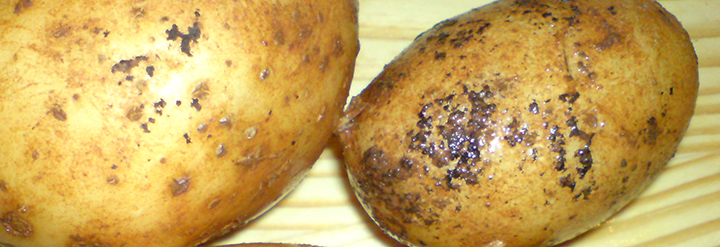Research Features
Postdoctoral research by Dr Norman Muzhinji in the Potato Pathology Programme at the Forestry and Agricultural Biotechnology Institute (FABI) sheds light on the genetic structure and diversity of Spongospora subterranea f. sp. subterranea in four potato-growing regions in South Africa, providing valuable insights on its management. Outcomes from this work appear in an article in the journal, Phytopathology.
The effective management of Spongospora subterranea f. sp. subterranea (Sss), one of the most important pathogens threatening potato production in South Africa, is hampered by limited knowledge of its population biology and diversity. Sssis the causal agent of powdery scab on tubers and galls in the roots of potatoes. Powdery scab reduces the quality of tubers destined for the market, while root galls impair growth and contribute to the build-up of the pathogen in the soil. The pathogen has proven difficult to manage, with the only reliable method of its control being the planting of disease-free tubers in uncontaminated fields.
The aims of this study by Dr Norman Muzhinji were therefore to evaluate the population structure and genetic variation of Sss in four potato-growing regions in the country and to determine whether root-and tuber-derived Sss samples are genetically differentiated. The four regions – KwaZulu-Natal, Limpopo, Mpumalanga and Sandveld in the Western Cape – were chosen to represent the climatic diversity of these regions and highlight the different environmental conditions in which the pathogen thrives.
The researchers analysed nearly 200 samples for this study – 172 samples from commercial potato farmers in the four regions as well as 27 samples from Colombia, South America, for comparison. This is because previous studies have shown Colombian populations of Sss to be the most diverse when compared to other regions in the world. The samples were screened against six microsatellite markers. Of the South African samples, 16 of the 75 multilocus genotypes (MLGs) were shared between the four regions. This indicates “substantial gene flow and countrywide dispersal of the pathogen”, wrote the authors. “The presence of common MLGs among the root- and tuber-derived samples indicated a lack of specialization of S. subterranea f. sp. subterranea to either tuber or root infection.”
Sss is highly adaptable and able to infect potatoes under a wide range of environmental conditions. The clonal and recombinant reproductive strategy of the pathogen demonstrated in this study allows it to maintain allelic combinations that are well adapted to certain environments, making it difficult to manage. Sustainable management of Sss relies on the use of epidemiological and evolutionary knowledge of the pathogen to develop an integrated programme, incorporating strategies such as host resistance, crop rotation, and chemical control. The results from this study highlight the importance of continued monitoring of pathogen populations and the need for improved and stringent phytosanitary measures to prevent movement of Sss-infected material into South Africa.


